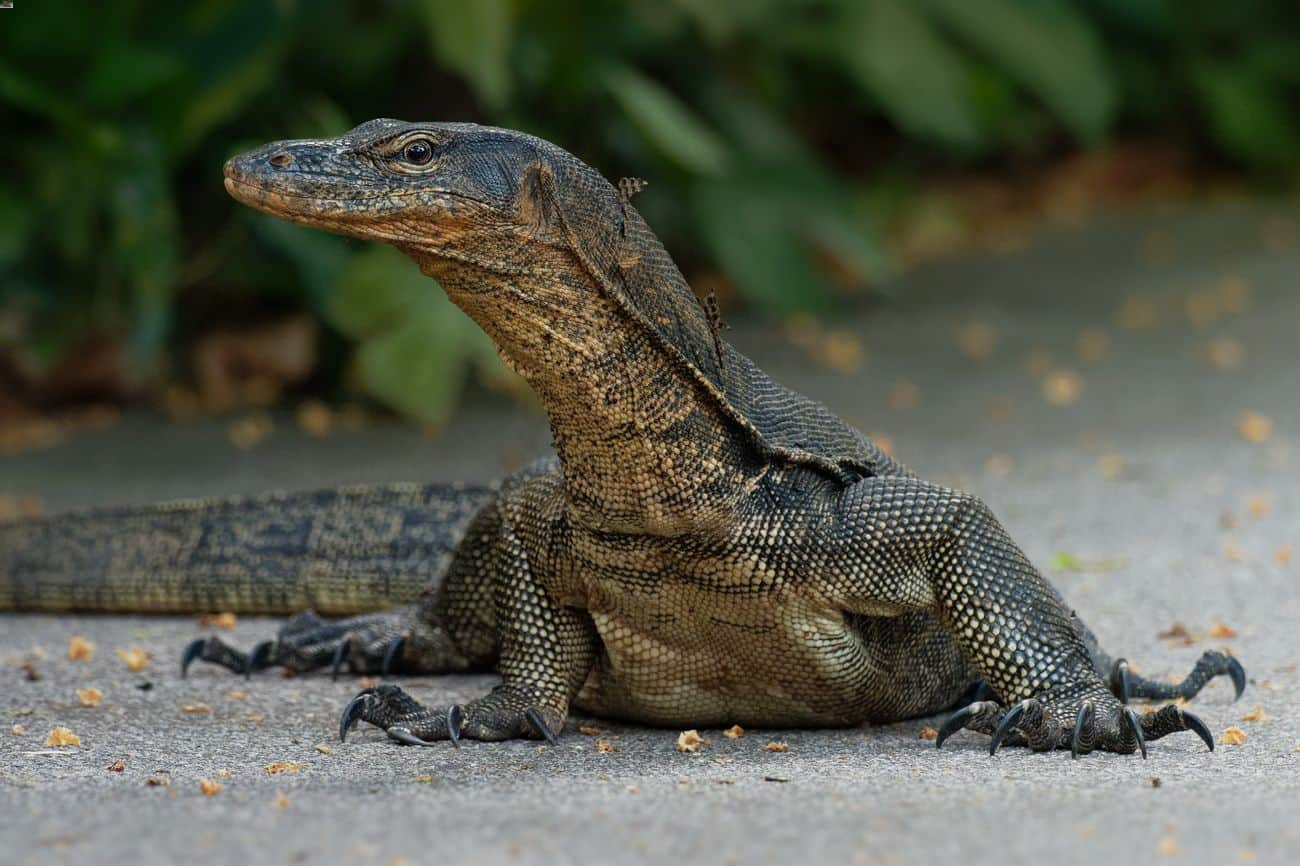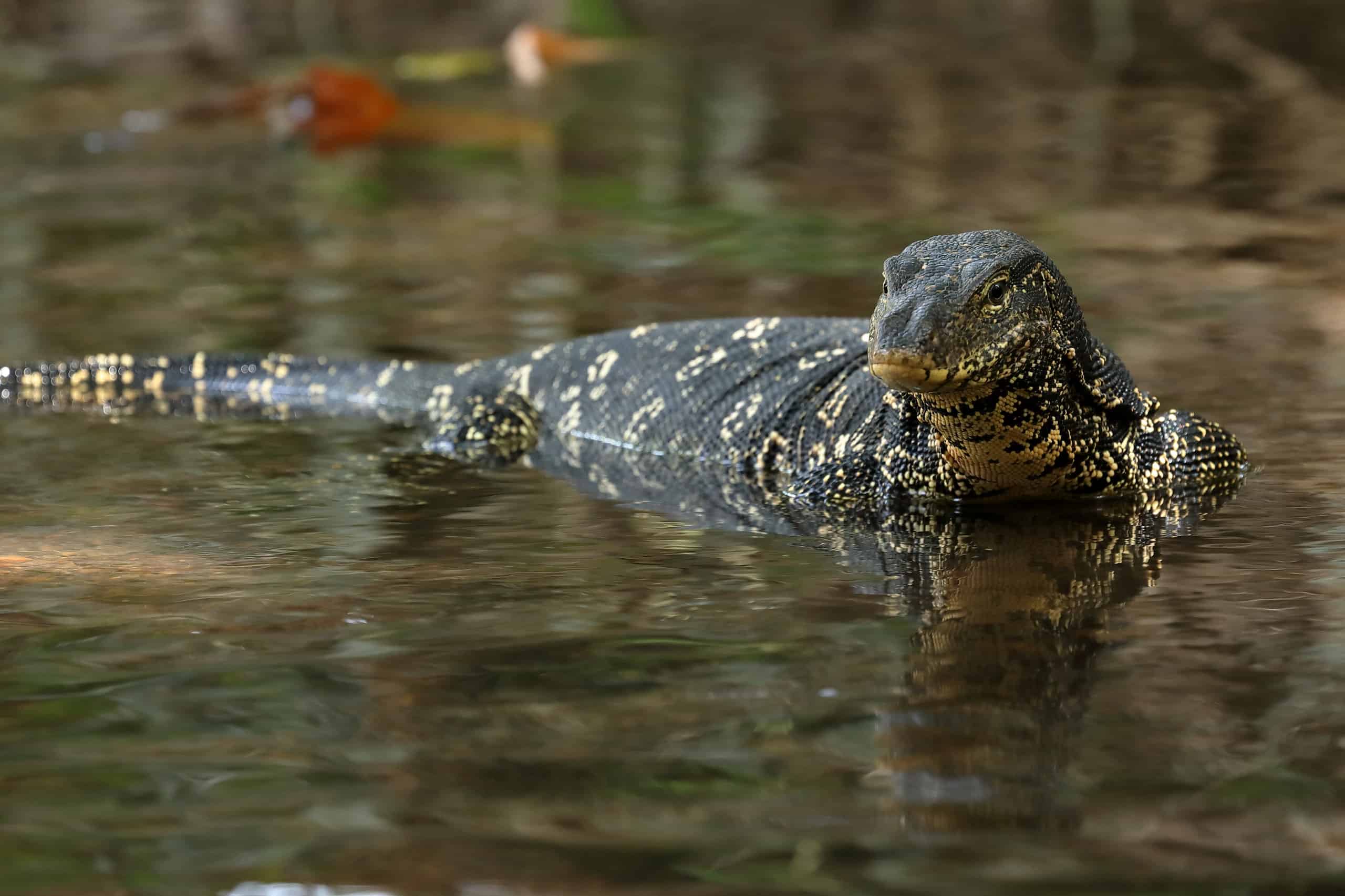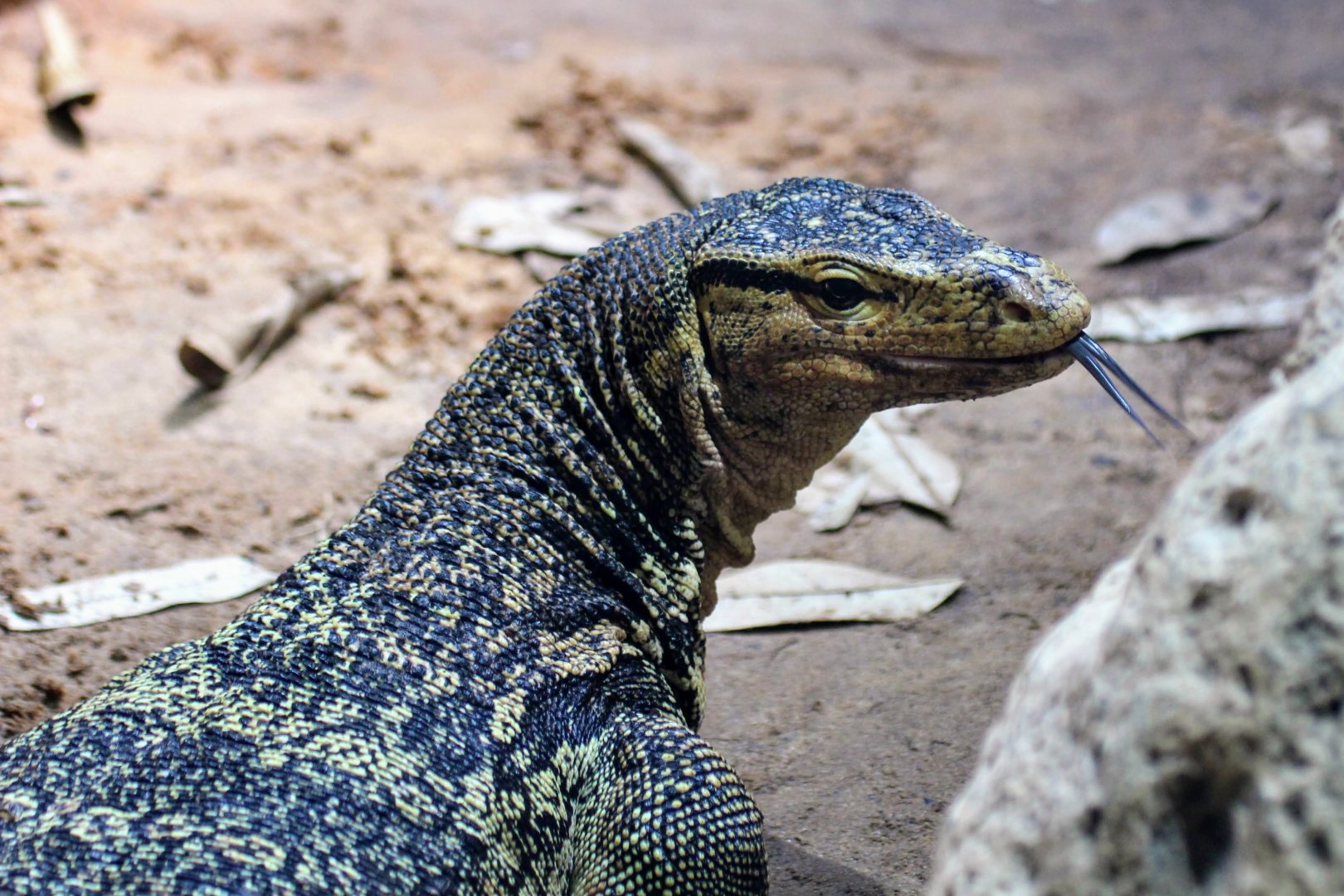Asian Water Monitor - A Big Lizard Story
When you think about the animal world, there are some creatures that truly stand out, and the asian water monitor is, quite frankly, one of those. This rather impressive animal, known in scientific circles as Varanus salvator, is a very large kind of lizard that makes its home in the warm, humid places of south and southeast Asia. It's a creature that, you know, has a certain presence about it, something that catches your eye. This particular lizard is a significant part of the natural landscape in its native areas, moving with a quiet power that is just something to behold.
This big reptile, which is more or less a giant among lizards, can be found in various spots across a wide stretch of the Asian continent. You might hear it called by a few different names, like the Sumatran water monitor or even just the common water monitor, but they all point to the same animal. It's a widespread creature, actually, living throughout big parts of southern Asia, and it seems to adapt quite well to different environments there. Its presence is, in a way, a familiar sight in many of these regions, showing just how well it fits into its surroundings.
What's interesting about this animal is that, despite its size and its use in various trades, it remains quite common. You might think that an animal so often sought after for things like its skin or for traditional remedies would be struggling, but that's just not the case here. The asian water monitor, as a matter of fact, is not considered to be in danger of disappearing, which is a good thing for the natural world. It continues to thrive, even with the annual trade involving its skin and other parts, which is, you know, quite a testament to its resilience.
Table of Contents
- What is the Asian Water Monitor, Anyway?
- Where Does the Asian Water Monitor Live?
- How Big Can an Asian Water Monitor Get?
- What Does an Asian Water Monitor Look Like?
- Are Asian Water Monitors in Trouble?
- The Asian Water Monitor and Its Powerful Build
- Why is the Asian Water Monitor So Widespread?
- What Makes the Asian Water Monitor So Remarkable?
What is the Asian Water Monitor, Anyway?
So, you might be wondering, what exactly is this creature we're talking about? Well, the asian water monitor, known scientifically as Varanus salvator, is a type of lizard that belongs to a group called varanids. These are a particular family of lizards, and the water monitor is, quite simply, a very big member of that family. It calls south and southeast Asia its home, which means you'll find it living naturally in those parts of the world. It’s a native animal there, meaning it has always been a part of the local wildlife, something that has been around for a very long time, you know.
This particular kind of monitor lizard is, in some respects, quite well-known across its range. It's often referred to by a couple of different names, which can be a little confusing at first, but they all point to the same animal. Sometimes people call it the Sumatran water monitor, perhaps because it's quite common on the island of Sumatra, or they might just call it the common water monitor. These different names just reflect how widely recognized it is in various places. It's a creature that, as a matter of fact, has a significant presence wherever it's found, and its various names are just a reflection of that widespread recognition.
The fact that it's one of the most common monitor lizards in Asia really tells you something about its ability to survive and thrive. It's not a rare sight, which is pretty amazing considering its size. In fact, it's among the largest of all the squamates, which is a group of animals that includes lizards and snakes. This means it's one of the biggest reptiles in its category, something that is, quite honestly, pretty impressive to think about. Its sheer size, coupled with its commonness, makes it a rather unique animal in the broader scheme of things, you know.
Where Does the Asian Water Monitor Live?
When we talk about where the asian water monitor makes its home, we're looking at a pretty wide area across Asia. This lizard is, basically, a creature of the wetlands and waterways, preferring places where there's plenty of water around. In the wild, you'll often find this water monitor in what are called mangrove swamps, especially in countries located in southeast Asia. These swamps are, in a way, perfect for them, offering both food and places to hide, which is something every animal needs.
Mangrove swamps, you see, are those special coastal environments where trees grow right in the saltwater, creating a really unique kind of ecosystem. They're often muddy and filled with tangled roots, which provides a lot of cover and hunting grounds for a creature like the asian water monitor. It's a type of place that, as a matter of fact, is full of life, and the monitor fits right in there. Its ability to move through both water and land makes these areas ideal for it to live and find what it needs to survive, you know.
The fact that it lives throughout large regions of southern Asia means it's a very widespread animal. It's not confined to just one small spot; instead, it's found across many different areas, adapting to the specific conditions of each place. This widespread presence is, in some respects, a sign of its adaptability and how well it can make a living in various watery habitats. So, if you're ever in those parts of the world, especially near water, there's a good chance you might, perhaps, catch a glimpse of this amazing animal.
How Big Can an Asian Water Monitor Get?
Now, let's talk about something that really makes the asian water monitor stand out: its size. These creatures are, to put it simply, true giants among lizards. They can grow to be quite large, reaching lengths of up to 3 meters, which is about 10 feet. To give you an idea, that's, you know, longer than many cars, or roughly the height of a basketball hoop. Imagine a lizard that long moving through the water or on the ground; it's a pretty impressive sight, actually.
This remarkable size places the asian water monitor in a very select group of animals. It's one of the largest species of monitor lizards on the planet, and in fact, it's second only to the famous Komodo dragon in terms of size. That means it's pretty much the second heaviest lizard in the entire world, which is, in a way, a truly astounding fact. When you consider the vast number of lizard species out there, for this one to be so big really says something about its place in the natural order.
Their sheer scale means they need a body that can support such a size, and they certainly have one. Their bodies are, basically, built with a lot of strength, having good, firm muscle throughout. This powerful build allows them to move with a great deal of force and agility, whether they're swimming or walking. So, it's not just about being long; it's also about having the kind of physical make-up that lets them handle their considerable dimensions, you know, quite effectively.
What Does an Asian Water Monitor Look Like?
Beyond their impressive size, the asian water monitor also has a very distinct appearance that helps it blend into its surroundings and, at the same time, makes it quite recognizable. Their bodies, which are, you know, quite well-built and full of muscle, are covered in a type of skin that feels quite strong and can withstand a good deal. This skin is not just tough; it also has a particular look to it, with a series of dark bands and spots that create a kind of pattern all over.
These patterns, the dark bands and spots, help the asian water monitor to camouflage itself among the shadows and light in its watery habitats. Imagine moving through dense mangrove roots or murky water; these markings help break up the animal's outline, making it harder for others to spot. It's a natural design that is, in some respects, very effective for its way of life. The texture of their skin, too, is scaly, which is typical for reptiles, providing a protective layer that is, basically, quite durable.
The species is also known for having a rather long tail, which is a key part of its overall look and function. This tail is not just for balance; it's a very powerful tool that the monitor uses for swimming and, in some cases, for defense. It's a significant portion of their total length, contributing to that impressive 10-foot measurement we talked about earlier. So, when you think about what an asian water monitor looks like, picture a creature with a strong, muscular form, tough, patterned skin, and a tail that is, you know, quite long and useful.
Are Asian Water Monitors in Trouble?
It's a common question when we talk about wild animals, especially those that are widely used by humans: are they in danger? For the asian water monitor, the answer is, thankfully, no. These creatures are not considered to be in danger of disappearing, which is, you know, pretty good news. They are, in fact, fairly common across their native range, even though their skins are used for making things like leather, and their bodies are also used as a source of protein in diets and for traditional medicine.
The fact that they remain common despite these uses might seem a little surprising at first glance. There's an annual trade in their skins and other parts, which is, basically, a continuous demand. Yet, the population numbers seem to hold steady. This suggests that the species is quite resilient and reproduces effectively enough to withstand the pressures from human activities. It's a situation that is, in some respects, a bit unusual, as many other animals facing similar levels of trade often see their numbers drop quite a bit.
Their adaptability and widespread presence likely contribute to their stable status. They can live in various watery environments, and they seem to be able to find food and shelter without too much trouble. So, while there is a market for their products, the asian water monitor appears to be able to keep its populations strong. It's a good example of an animal that, you know, manages to persist and thrive even when there's a certain amount of human interaction with its wild numbers.
The Asian Water Monitor and Its Powerful Build
When you consider the asian water monitor, one of the first things that comes to mind, after its size, is its sheer strength and how it's built. This species is, basically, known for having a body that is very powerful and full of muscle. It's not just big; it's also incredibly well-put-together, allowing it to move with a lot of force and purpose. This muscular build is, you know, a key part of what makes it such an effective hunter and survivor in its natural environment.
The strength in its body extends to its long tail, which is not just for looks. The tail is, in a way, a very important tool for the monitor. It uses it for propulsion when it's swimming through water, helping it to glide along with considerable speed and grace. On land, the tail also provides balance, especially when the animal is moving quickly or trying to climb. It’s a versatile appendage that is, as a matter of fact, essential to its daily life and its ability to get around.
Their robust, muscular bodies are, you know, truly a sight to behold. They are covered in that tough, scaly skin we talked about, which acts like a natural armor. This combination of a strong, flexible body and a protective outer layer means they are well-equipped for their lives in the wild. They can navigate through dense vegetation, swim through strong currents, and, basically, hold their own against whatever challenges come their way. This physical makeup is, in some respects, what allows them to be such dominant figures in their habitats.
Why is the Asian Water Monitor So Widespread?
One of the interesting things about the asian water monitor is just how common and widespread it is across its home range. It's a large reptile that, you know, lives throughout a vast portion of Asia, from the southern parts to the southeast. This wide distribution is not something every large animal can achieve, and it speaks volumes about the monitor's ability to adapt and make a living in different kinds of places. It's a testament to its flexibility, actually.
Its ability to live in various environments, particularly those with water, helps it spread out so much. Whether it's mangrove swamps, rivers, canals, or even urban drainage systems, the asian water monitor can, more or less, find a way to exist there. This adaptability to different watery habitats means it's not limited to just one specific type of landscape, which is a big reason why you find it in so many different areas. It's a creature that, as a matter of fact, seems to be quite resourceful when it comes to finding a place to call home.
The fact that it's one of the most common monitor lizards in Asia also points to its successful survival strategies. It reproduces effectively, finds enough food, and can, basically, avoid or deal with threats. This combination of being able to live in many different places and being good at surviving means its populations can stay strong and spread out over a very large geographical area. So, its widespread presence is, you know, a sign of a species that is doing quite well for itself in the natural world.
What Makes the Asian Water Monitor So Remarkable?
When you take a moment to consider the asian water monitor, it truly stands out as a remarkable lizard native to south and southeast Asia. There are several things that make it so special, setting it apart from many other creatures. Its impressive size is, you know, certainly one of the first things that comes to mind, being one of the largest lizards on the planet. But it's more than just its physical dimensions; it's also about how well it fits into its world.
Its adaptability is another key feature that makes it so noteworthy. The fact that it can thrive in a variety of watery habitats, from natural swamps to areas touched by human development, shows a great deal of resilience. This ability to adjust to different surroundings means it can, basically, find a way to survive and prosper in many places where other animals might struggle. It's a creature that, as a matter of fact, seems to make the most of whatever environment it finds itself in.
Being the second heaviest lizard in the world, just after the Komodo dragon, really puts its size into perspective. This kind of physical presence, combined with its strong, muscular body and long tail, makes it a very capable animal. It’s known for its strength and its ability to move with purpose, whether it's hunting or just getting around. So, the asian water monitor is, in some respects, a true marvel of the reptile world, a big, adaptable creature that continues to make its mark across a wide part of Asia, something that is, you know, pretty incredible to think about.

Asian Water Monitor 101: Care, Size, Lifespan & More!

Asian Water Monitor Animal Facts - Varanus salvator - A-Z Animals

Asian Water Monitor - ZooChat